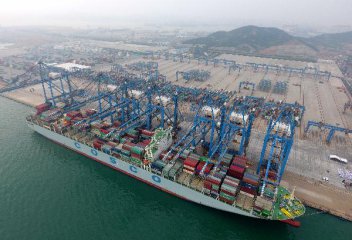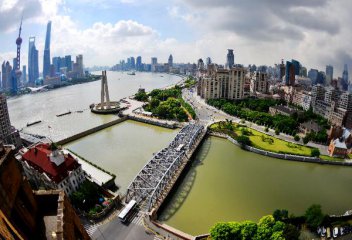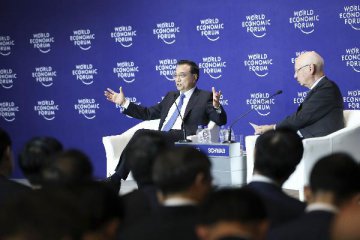
China’s foreign trade maintained a high growth of 19.6 percent in the first half, the highest growth in a half since the second half of 2011.
The Ministry of Commerce (MOFCOM) is promoting improving the international trade market layout, domestic regional layout, product structure for foreign trade, operation entities’ structure and trade models, it indicated at the press conference held by the State Council Information Office on July 31.
The improvement and upgrading have shown results in the first half. It boosted the trade growth in emerging markets, including those along the Belt and Road routes. Central and western regions played more important roles in foreign trade. The import and export of high-tech products with high added value were highlighting. Cross-border e-commerce, market procurement and other new trade models and business types also achieved high growth.
MOFCOM indicated that Chinese government remains policies supporting encourages competitive and qualified enterprise going out unchanged. It will give sustainable supports to those participating in the Belt and Road initiatives, the international capacity cooperation and benefiting the structural upgrading of domestic industries. Meanwhile, it will curb irrational outbound investment in property, hotels, sports, entertainment and other industries and guide enterprises to invest in real economies.
UAVs exports nearly double
Based on the international market layout, China highlights the foreign trade with emerging markets, including those along the Belt and Road routes. The import and export with countries along the Belt and Road routes saw higher growth. The import and export with the ASEAN, India and Russia increased 21.9 percent, 30.4 percent and 33.1 percent, respectively, indicated Qian Keming, Vice Minister of Commerce.
Customs data shows that the import and export with countries along the Belt and Road routes increased 23.4 percent in the first half. The import and export with African countries hiked 28.3 percent in the same period.
“China’s industrial structure can complement with countries along the Belt and Road routes and other emerging countries. China’s infrastructure capacity also meets their infrastructure demands. They have become the main target in the exploration of overseas markets by China.” Bai Ming, deputy director of the MOFCOM’s research institute, indicated.
The freight of different transportation vehicles also shows the changes in the market structure. The foreign trade transportation through railways and roads increased over 20 percent in the first five months. The road transportation is mainly with neighboring countries and the railway transportation is mainly with countries along the Belt and Road routes and Eurasia Land Bridge. The foreign trade in these regions saw higher growth.
As for the domestic regional layout, the foreign trade in central, western and eastern regions saw an increase of 26.8 percent, 25.7 percent and 18.5 percent, respectively.
Bai pointed out that in the improvement in the domestic regional layout, China strengthened the foreign trade in eastern regions and gave play to the role of central and western regions in foreign trade.
Bai believed that central and western regions enjoy comparative advantages in land, labor and other factors. With complete infrastructure, they can assume the transfer of industries. On the other hand, it is required in the opening of China. Central and western regions are pioneers in the Belt and Road initiatives.
As for the product structure, the exports of mechanical and electrical products saw higher growth than labor-intensive products. Medium- and high-end manufacturing industry is playing an increasingly supporting role in the economic growth. The exports of certain mechanical and electrical products and equipment with high added value maintained high growth. For example, the exports of vehicles, ships and unmanned aerial vehicle (UAVs) increased 32.5 percent, 25.1 percent and 93.4 percent in the first half.
Meanwhile, new business types in foreign trade also surged. The import and export in cross-border e-commerce hiked 66.7 percent while the market procurement trade jumped 27.8 percent.
Bai indicated that China is greatly promoting the development of such new business types in foreign trade as market procurement, comprehensive service platforms and cross-border e-commerce.
“Market procurement is equivalent to retails in international trade, but it streamlined the procedures for small and medium foreign traders. Comprehensive service platforms are mainly for small and medium enterprises. They provide services in logistics, insurance and customs clearance for enterprises in one platform.” Bai indicated that cross-border e-commerce reversed the inferior position of China’s foreign trade in the smiling curve. China’s e-commerce market has preliminarily established competitiveness in the international market.
Outbound investment in property, culture, sports and entertainment plunge
China’s foreign trade in the first half is characterized by the recovery in foreign trade and the declining cross-border investment.
Qian indicated that the outbound investment is more rational in the first half. The outbound direct investment stood at 331.1 billion yuan, declining 42.9 percent. Irrational outbound investment has been effectively curbed.
Compared a decrease of over 40 percent in outbound investment, the investment in countries and regions along the Belt and Road routes slid just 3.6 percent.
Meanwhile, enterprises paid more attention to investments in real economies. The investment in overseas manufacturing sectors saw fewer decreases in those in property, culture, sports and entertainment sectors.
Based on the MOFCOM’s statistics, China’s outbound investment in property plunged over 82 percent in the first half, accounting for 2 percent of the total outbound investment of China in the same period. In addition, outbound investment in culture, sports and entertainment sectors also plummeted 82.5 percent, accounting for 1 percent of the total outbound investment in the same period.
Qian indicated that another reason for the declining investment is that various ministries and commissions introduced regulatory measures. They strengthened the review on the authenticity and regulation compliance of outbound investment and guided enterprises to invest in real economies to reduce the investment in property, culture, sports, entertainment, sports clubs and other industries.
“We have tightened the review of the authenticity and regulation compliance on the overseas investment, hoping to guide more investment into the real economy and to reduce investment in sectors such as real estate, hotels, entertainment and sports,” Qian said.
Long Guoqiang, deputy head of the State Council’s Development Research Center, said it is necessary for the government to properly manage and regulate cross-border investment to avoid massive fluctuations of cross-border capital flow.
Bai indicated that outbound investment faces various external risks. The irregular operation of certain enterprises in outbound investment will result in financial risks.
Such activities may include false investment, assets transfer and other activities. Besides, some enterprises even left the risks to domestic financial institutes through domestic acquisitions with high leverages.
Qian emphasized that China has and will not change its policies of encouraging competitive and qualified enterprise going out. It still encourages real and compliant outbound investment following domestic laws and regulations as well as common international rules.
“We particular encourage outbound investments in the Belt and Road initiatives and the international capacity cooperation to benefit the upgrading of the domestic industrial upgrading.” Qian said.
Long believed that last decade saw the highest growth in China’s outbound investment. It has hiked from 2.85 billion U.S. dollars in 2008 to 170.1 billion U.S. dollars in 2016. China’s economic development has entered into a new stage for the consolidation of global resources and markets.
“Despite various regulatory measures, China will remain its policies supporting enterprises to conduct outbound investment unchanged. China’s position as a major outbound investor will not change.”
Translated by Star Zhang
























Latest comments